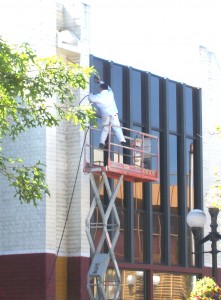Does working on a scissors lift require fall protection?
Recently a vigorous online discussion erupted over this question when it was asked on an online message board. When I last checked over 140 people had expressed a wide variety of fact and opinion.
The question itself was simple to answer: "No, OSHA doesn't require an employee to use fall protection when using a scissors lift (i.e., work platform that cannot be positioned completely beyond the base) if the guardrails are installed and the gates closed." In fact, the scissors lift itself is a form of fall protection which protects workers from the hazards of working from portable ladders. Some group members pointed out that other government standards such as the USACE's EM-385-1-1 (used on many government projects) require users to tie-off if the lift was equipped with anchor points. In a few months all the scissors lifts used on these projects must have anchor points and workers will be required to use them.
But then the discussion turned to the question of whether requiring fall restraint in a lift is a best safety practice.
One argument for tethering workers was that there's a tendency for workers to climb the guardrails and a fall restraint system would keep the worker's feet on the platform (which is required by OSHA). This seems to make sense until you consider that a worker who's willing to violate rules by climbing the guardrails is probably also going to violate the rule that prohibits them from unclipping their fall restraint system.
It would seem that the root cause of the hazard in this situation is workers who aren't following the "don't climb the guardrails" rule. In this case wouldn't it make sense to address this issue first? After all, if workers are not following safety rules that needs to be the focus of your corrective measures instead of adding another layer of rules that may or may not be followed.
Another important source of guidance to answer this question would be the manufacturers. Their manuals always seem to recommend, but not require, fall protection and the newer lifts all seem to include anchor points. Wouldn't it be prudent to follow these recommendations? Maybe yes, but maybe no.
On one manufacturer's web site you can see users connect a 6-foot lanyard to an anchor point located on the lift's mid-rail. This is not a restraint system. It would allow the worker to potentially over the side of the lift and generate a considerable sideways force as the system arrested the worker. On a fully extended lift, I would suspect that the lift would then tip. You could make the argument that equipping workers in this fashion would actually encourage them to climb the guardrails since they might feel (falsely) that the fall arrest system will protect them.
Some commentors made the argument that if you don't comply with all the manufacturer's recommendations you might to exposing yourself to liability, but employers are exposed to liability every business day and simply creating a policy based on a recommendation may serve the cause of compliance, but not necessarliy advance the cause of safety.
As the discussion evolved people seemed to associate themselves into safety or compliance camps.
Here's the text of one of the responses that I posted.
Seems to me like we sort of have two different trains of thought being expressed here. One group is talking about compliance (with USACE regs and manufacturer recommendations) and the other (I guess I'm in that camp) is talking more about safety.
I understand the essential role that rules play in safety and if the fall protection requirements on the site are spelled out, then the discussion is over.
But I work in the safety field and while when dealing with gray areas (OSHA doesn't require it, USACE does on some lifts, manfacturer recommends it), I am not a proponent of simply applying the most stringent interpretation of the most stringent rules to avoid having to analyze what's really going on.
If I were being paid to answer this question for a client I would do so by applying the basic safety processes we all use.
1) Break the work into steps
2) Analyze each step (who, when, where, what tools/cords/materials, nearby work activities, etc.)
3) ID the hazards in each step
4) Apply the heirarchy of controls to manage the hazards.
I don't know what the end result of this would be. Might be a restraint system, or a vertical lifeline, or nothing besides the guardrails. It could be each at various stages of the job. Who knows until you do the analysis?
As in medicine, safety should involve both diagnostics and therapuetics.
I'm sure that this discussion will continue but I think the most important consideration needs to be on the process through which we arrive at a means of addressing hazards rather than simply requiring this or that without truly thinking through the consequences.
